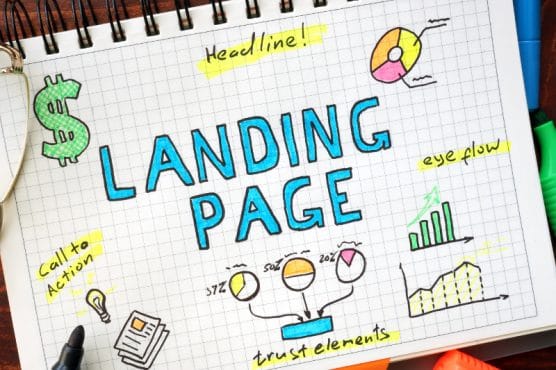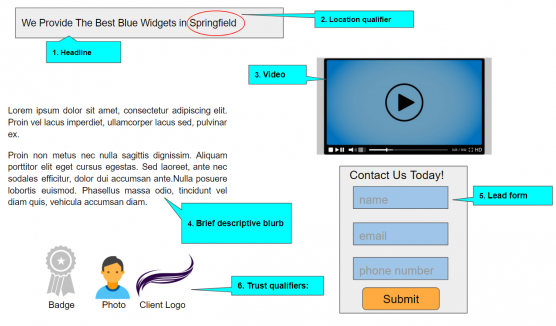
In the most general sense, a landing page is any page on your website that could serve as the first page a user reaches. Although we often think of the homepage as the starting point for website visitors, most users will arrive at your site via another page.
For example, consider a website selling hardware. If a user searches for “electric lawn mowers” in Google, she may click a Google listing pointing her to the “electric lawn mower” page of the website. In this sense, she has “landed on” the category page for electric lawnmowers and it is the “landing page” for her visit.
From a marketer’s perspective, the concept of a landing page takes on an additional meaning as a purposeful destination that we want users to reach via an ad, a Google search, a social media post or other marketing channels. The best landing pages are designed to get users to do something such as buy a product, complete a lead form, register for a webinar, or download a brochure.
For this article, we are referring to purposeful landing pages that help achieve a marketing goal.
A landing page focuses on getting the user to do one thing and only one thing. Navigation and content are stripped down to help achieve the marketer’s singular goal — whatever that goal may be.
Landing pages are a key ingredient to a successful ad campaign but are often overlooked by advertisers who opt to send visitors to their website’s homepage or an existing interior page.
While, technically, any page that a visitor lands on after clicking an ad is a landing page, not all landing page experiences are created equal. Effective landing pages are:
- developed with conversion goals in mind
- routinely tested and compared with variations
- refined based on performance
Landing Page Example

The above landing page example includes six elements of a basic landing page. Notice there’s little content and no navigation. Viewing the video or filling out the form are the only actions a visitor can take. The following is an explanation of each element on the above page. Here are the elements listed in the above graphic:
- Headline: A great headline can boost conversion rate by 41% source
- Location qualifier: Adding personalization, such as the business location, can increase revenue by 6 to 10%.
- Video: Landing pages with video can increase conversions by up to 80%.
- Brief descriptive blurb: Landing pages with more than 800 words have a 33% lower median conversion rate than pages with less than 200 words. source
- Lead form: Shorter forms are generally better for conversions, but not always! It’s important to test different form lengths to find what works for you.
- Trust qualifiers: Adding elements like award badges, client logos, and photographs of real people helps establish trust and can add credibility to your page. source
Your Website Is Not Your Landing Page
You may have spent thousands or tens of thousands of dollars on your website. It may be responsive, fast, and boast a modern design. All of that is great, but it’s still not a landing page. This is because your website serves a variety of purposes that may include providing company and product information, establishing industry expertise in the form of relevant content such as blog posts and videos, and employee recruitment (to name a few).
Sites with multiple goals that also contain multiple layers of content are great for organic traffic, like search engine listings and social sharing, but can be detrimental to paid media goals which are generally more conversion-oriented. Even the most basic element of usability – your site’s navigation – can hurt your conversion rate.
Hubspot ran a test utilizing 5 different incentives, including a free ebook, a free SEO template, a content creation kit, a free trial, and a demo. For each offer, Hubspot created two landing pages – one with navigation and one without.
- 4 of the 5 pages without navigation saw a lift in conversion rate ranging from 2% for a free ebook, to as high as 28% for an online demo.
- This conversion rate lift was the most significant for users lower in the buying funnel (e.g., those considering purchase compared with window shoppers).
While this is a small test, it certainly makes the case for stripping out navigation and testing the navigation-free pages against your existing landing pages.
Landing Pages Help You Leverage Your Media Spend
Self-serve advertising platforms like Google Ads and Facebook Ads make it tempting to launch a digital campaign quickly, particularly for new advertisers, but rushing a campaign’s launch can equate to wasting money on traffic that doesn’t convert well or at all. If you’re investing in paid media and care about cost per acquisition (how much you’re paying to get a lead or make a sale), you need to invest in at least a few dedicated landing pages.
One of the biggest oversights we see our clients make is that they want to advertise immediately, but their websites aren’t properly set up to capture leads, sales, or other key performance indicators (KPIs) prior to launching their ads. But even if your site is set up to capture leads and sales, if it doesn’t have landing pages, it can still be a poor place to send paid media, particularly paid search traffic.
The 4 Biggest Landing Page Mistakes:
#1. The page isn’t specific to the information the user searched for. For example, consider a user who searched for “accounting software.” Do you send the user to a page that describes all your software options and let her filter down to the “accounting” category? Or, do you send the user to a page dedicated to accounting software specifically? The former is likely to frustrate a user and cause her to click away. The latter is more likely to keep her attention and lead to a conversion.
#2. Site navigation takes the user away from your primary goal. This is a tricky one because often we want to empower users to explore our full array of products or services, and to learn more about our company. However, for a marketing campaign that has a specific lead capture goal, giving the user too many options to click away without completing that goal can be detrimental to conversion rates.
#3. The page is written for the wrong audience. Revisiting our earlier example of “accounting software,” consider a user who searched for “restaurant accounting software” and assume this is one of your primary offerings. The optimal landing page for this campaign is going to address the needs, concerns, worries, and goals of a restaurant manager or owner. A generic page about accounting software simply cannot do this. You need a landing page dedicated to restaurant accounting software.
#4. The page lacks a clear call to action. Do you want the user to make a purchase, download an ebook, or give you a call? If the page isn’t crystal clear about its intent or provides too many options for users, conversion rates will suffer.
We’ve Convinced You That You Need A Landing Page, So Now What?
There are a number of ways to approach landing page creation, execution, and testing. You could create the page yourself if you have the design and programming resources (or work with a web development agency to create the pages). These can be hosted on your website just like every other page, but with limited navigation. Linking to the home page and your privacy policy may suffice.
If you don’t have the programming and design resources in-house and would prefer not to use an agency, then you can employ a conversion rate optimization service that specializes in landing page creation, implementation, and testing.
These include companies like Unbounce, HubSpot, and Leadpages. Tools like these typically include landing page templates that are mobile-friendly and relatively easy to implement.
Google Analytics also has a built-in feature that lets you easily A/B test different versions of a landing page. This feature, Content Experiments, lets you test up to ten versions of a landing page at once.
Let’s End with Some Landing Page Statistics
In many ways, landing page optimization (also called “conversion rate optimization”) gives you the ultimate competitive advantage in a cluttered digital media landscape. It’s impossible to control competition, CPC bids, and ad impression share, but you have complete control over where you send your paid visitors.
Still, landing page testing and optimization is an underutilized tactic. Hubspot reports that of the companies that are using landing pages, 68% have six or fewer pages. Maybe more companies would leverage landing pages if they knew some stats.
- Companies see a 55% increase in leads when they increase the number of their landing pages from 10 to 15. source
- Landing pages with one call-to-action have an average conversion rate of 13.50%. source
- 29.5% of landing pages have too much copy — and an average conversion rate of 11.10%. Landing pages with shorter word counts convert on average at 14.30%. source
- 44% of clicks for B2B companies are directed to a home page vs. a landing page. source
There are seemingly endless ways to drive traffic to your website. You want to monetize that traffic as effectively as possible, and landing page usage and optimization is the way to do this.
Chuck Bordman and Will Rico contributed to this article.
Share this
You May Also Like
These Related Stories
AdWords Rolls Out Dynamic Sitelinks

AI In Content Marketing - What You Need to Know
